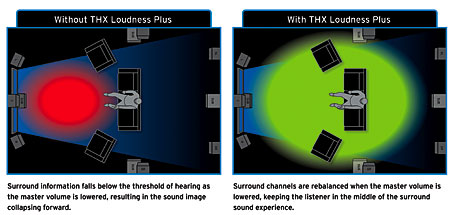Tune In, Turn Down, Turn On!
You know the drill. You’re just getting into the latest action blockbuster on your new home theater rig when a still, small voice wafts gently into your SPL-addled ear. “Isn’t that a bit loud?” Or perhaps the voice comes screeching in from another room. “I can’t hear myself think in here.” Or there’s a knock at the front door from the men in blue, demanding that you surrender your assault rifle in exchange for a fun stay in the slam with Tony the Hammer.

But even the most enthusiastic of us rarely play back movies at reference level—an average sound pressure level of 85 decibels with peaks that can reach 105 dB. However, at low levels, the human ear is less sensitive, particularly to very low and high frequencies. You lose some of the gut-wrenching thrills that send chills up your spine, which is a likely result of the instinctive fight-or-flight response.
This issue was first tackled decades ago with the invention of the loudness control. In its original form, it boosted the bass (and sometimes the treble) progressively when you reduced the playback level. While it was well intentioned, it was eventually dumbed down to the point where it boosted the response by the same degree regardless of the volume control setting. As a result, most listeners used it as a supplement to their (usually) maxed-out bass and treble controls, to the consternation of audio purists and long-suffering woofers and tweeters everywhere.
Flash forward to today. With digital processing, we can now analyze how our hearing responds to level changes in more sophisticated ways. This process is called psychoacoustic modeling. Using the data from such models, digital algorithms can compensate for these differences on a dynamic (real-time) basis.
That’s exactly what three technology companies have done to one degree or another: Audyssey (Dynamic EQ and Dynamic Volume), Dolby (Dolby Volume), and THX (THX Loudness Plus). None of these companies builds consumer products. Instead, they license the results of their research and development processing to manufacturers that do. With one of these features in your A/V receiver or surround processor, low-level listening is no longer less fun than an IRS audit.
THX Loudness Plus
THX Loudness Plus is implemented in the latest THX Ultra2 Plus–certified surround processors and A/V receivers, THX Select2 Plus–certified A/V receivers, and THX I/S Plus–certified integrated systems. It determines your system’s reference level during channel calibration and uses it as a baseline.

This process uses two proprietary technologies. THX Multi-channel Spectral Balancing evaluates the program’s tonal balance in real time and alters it to compensate for the ear’s loss of sensitivity at lower listening levels.
In addition, when you reduce the playback level, the front channels will, at some point, totally swamp any audible contribution from the (typically) lower-level sound from the surrounds. THX Dynamic Ambience Preservation, the second part of the THX Loudness Plus process, increases the surround level as needed to provide the same impact from the surrounds that you would hear at reference level.
Apart from those two tongue-twistingly named operations, THX makes no elaborate claims or explanations for its processing. It simply states that it applies progressively higher levels of equalization to all the channels in a proprietary but straightforward way as listening levels are reduced. It readjusts front-to-rear balance as needed in a similarly straightforward fashion. The processing assumes that the source was recorded at reference level on an industry-standard monitoring system (Society of Motion Picture and Television Engineers—SMPTE) and that you’re playing it back on a good-quality, properly set-up and calibrated home theater system.




























































